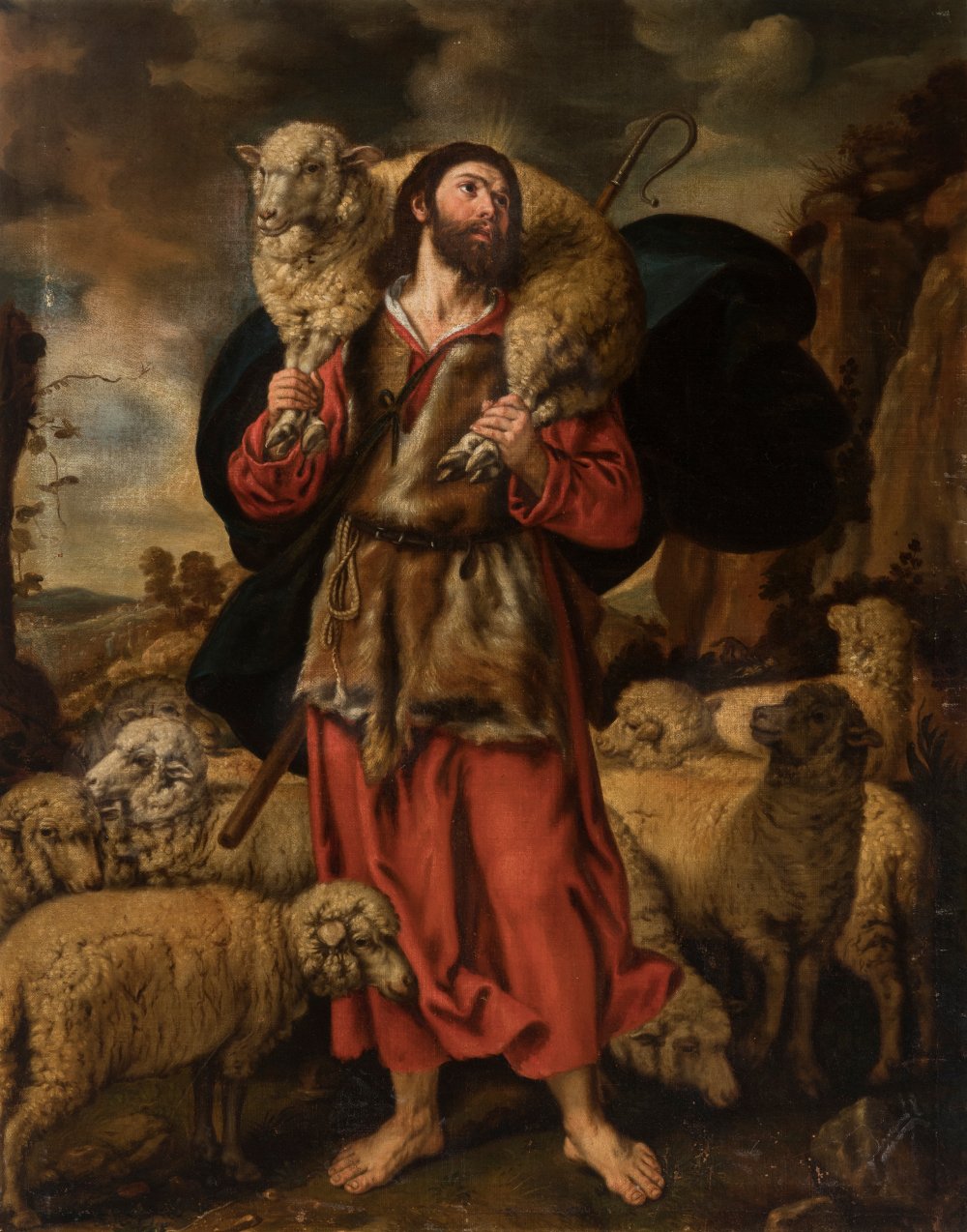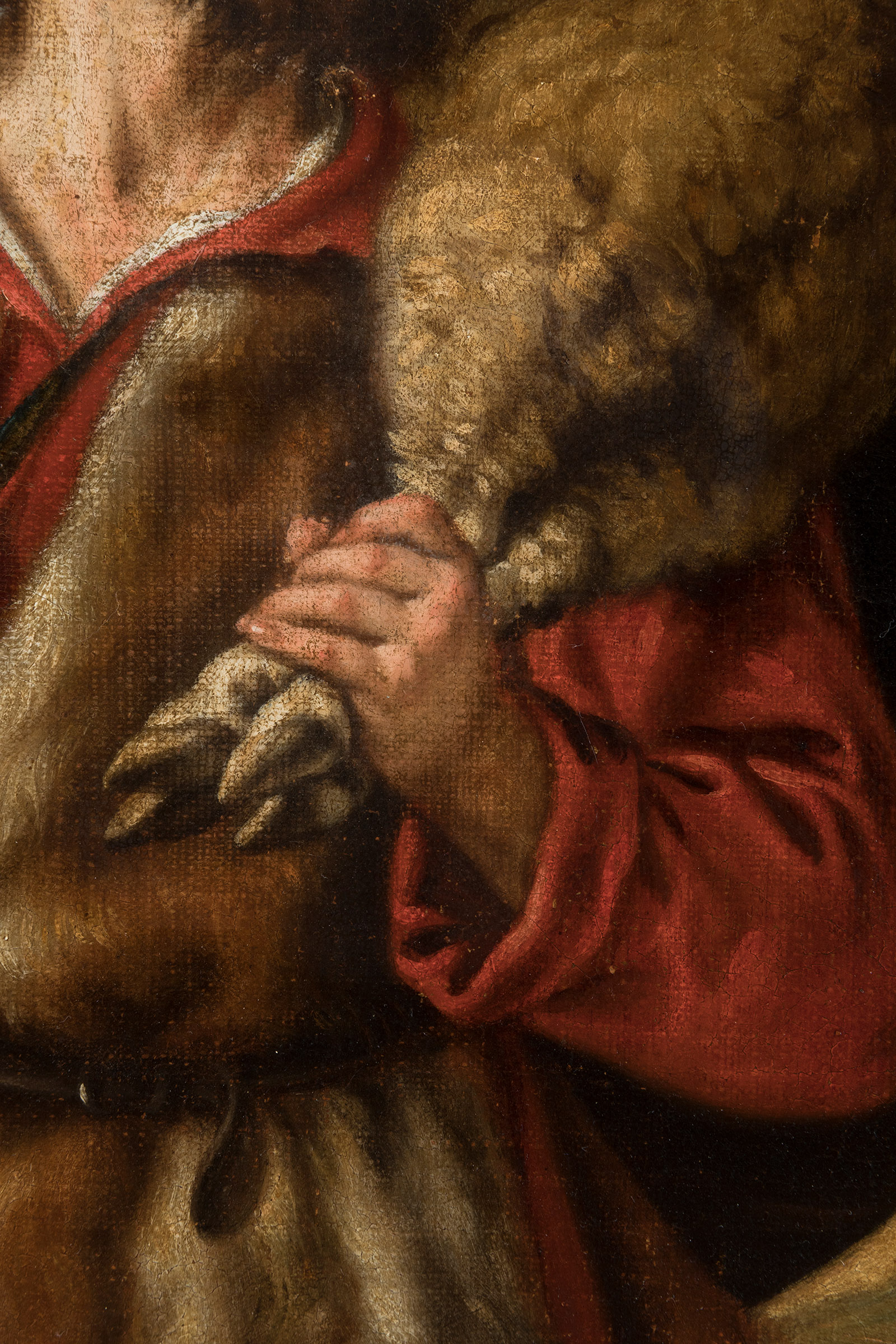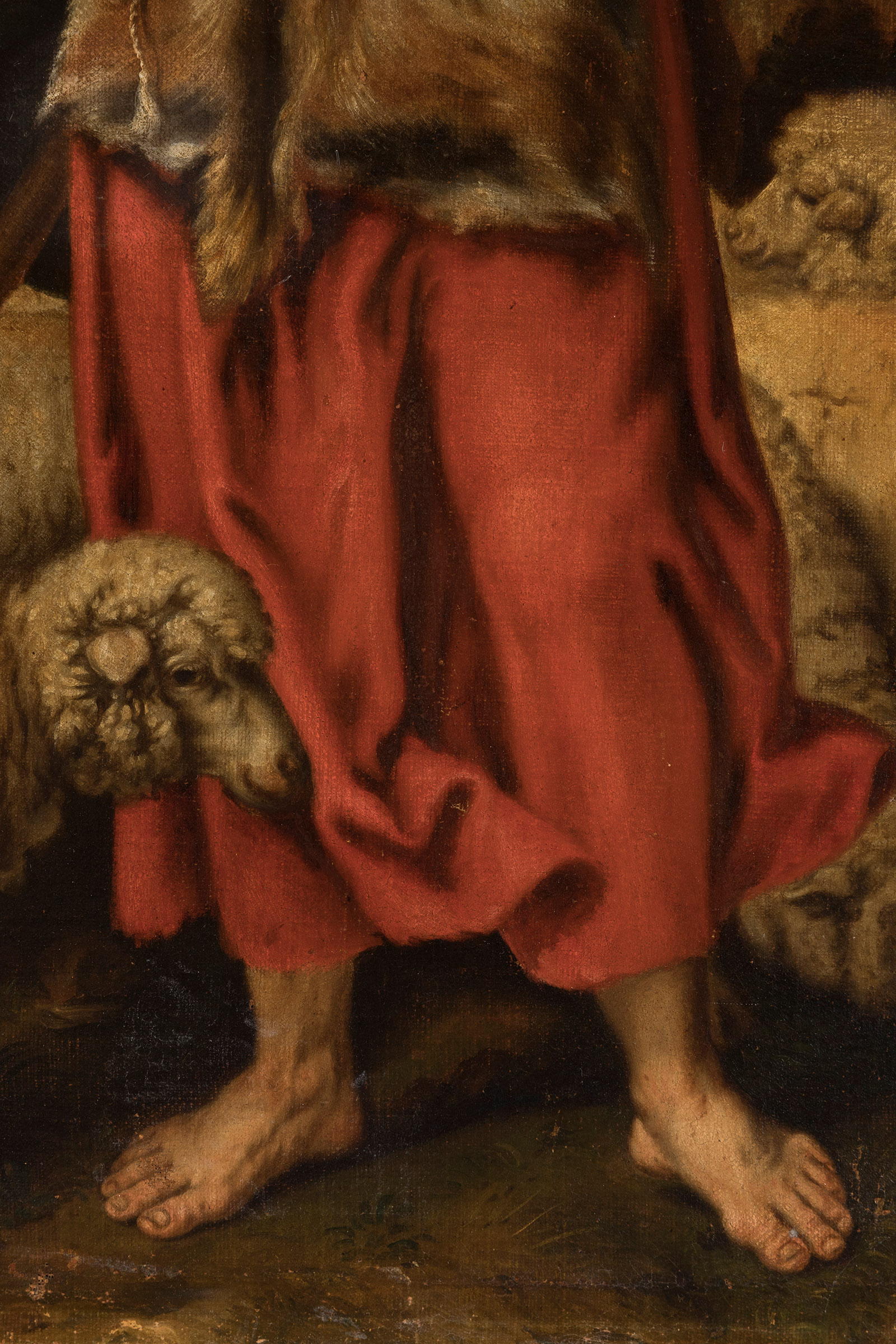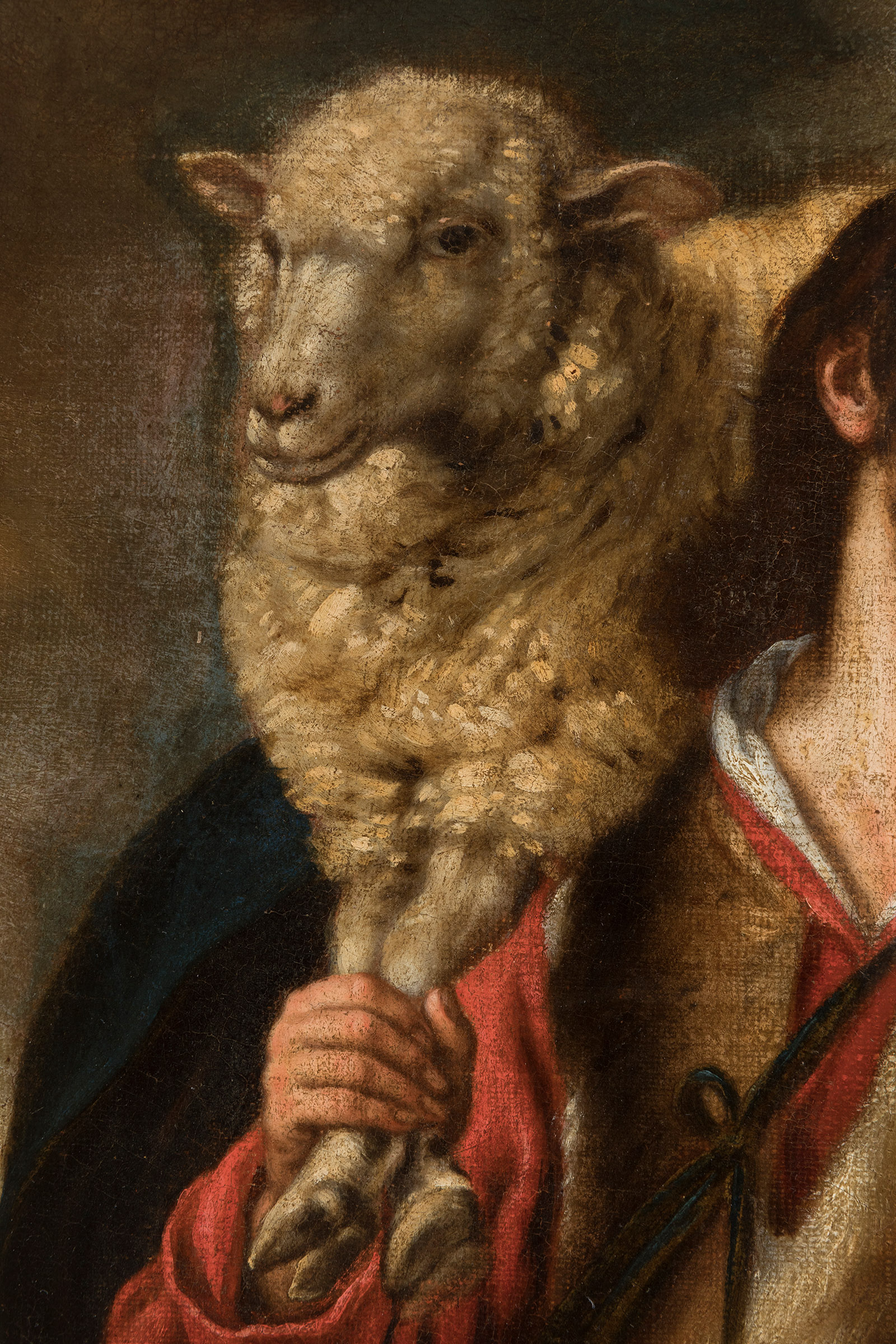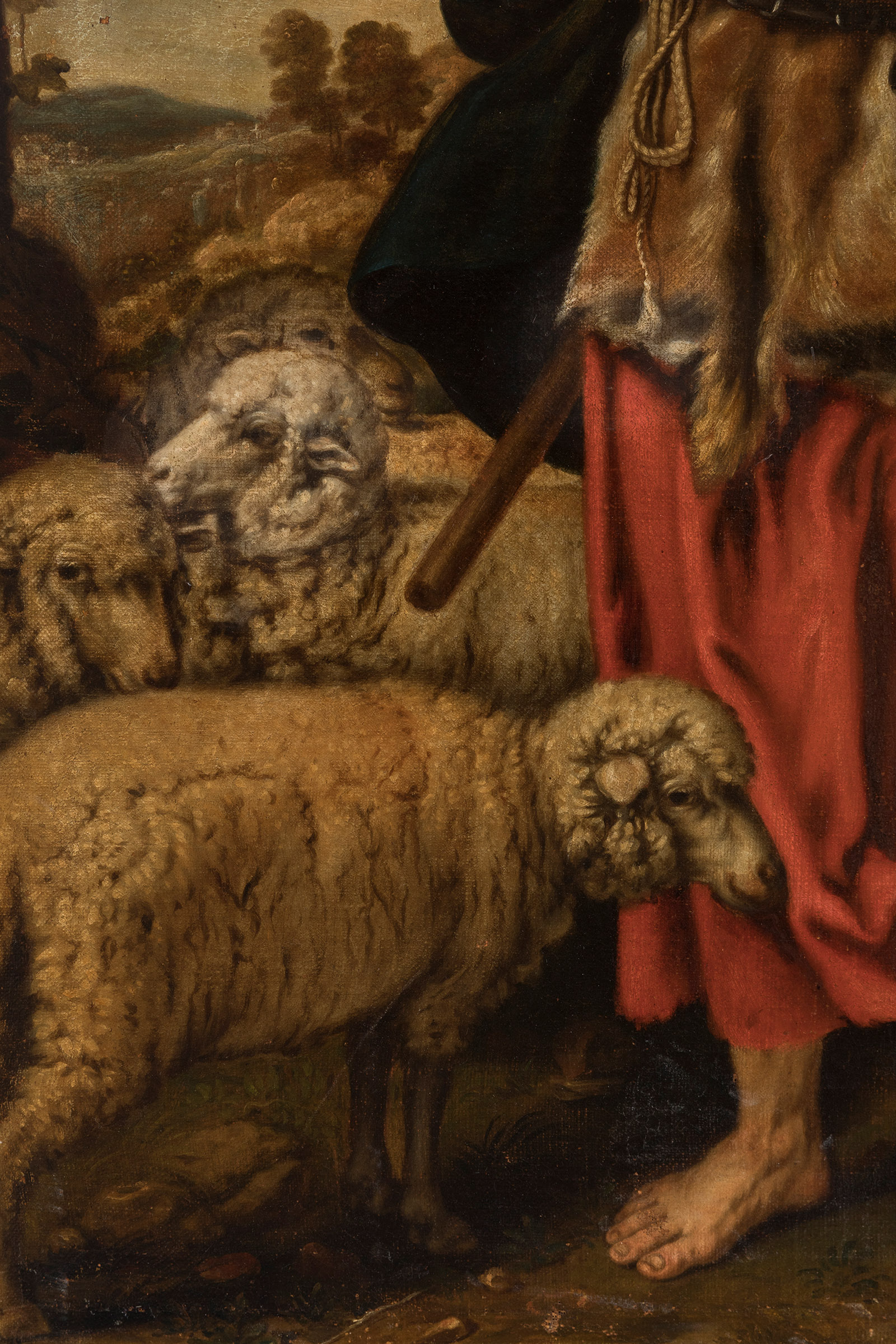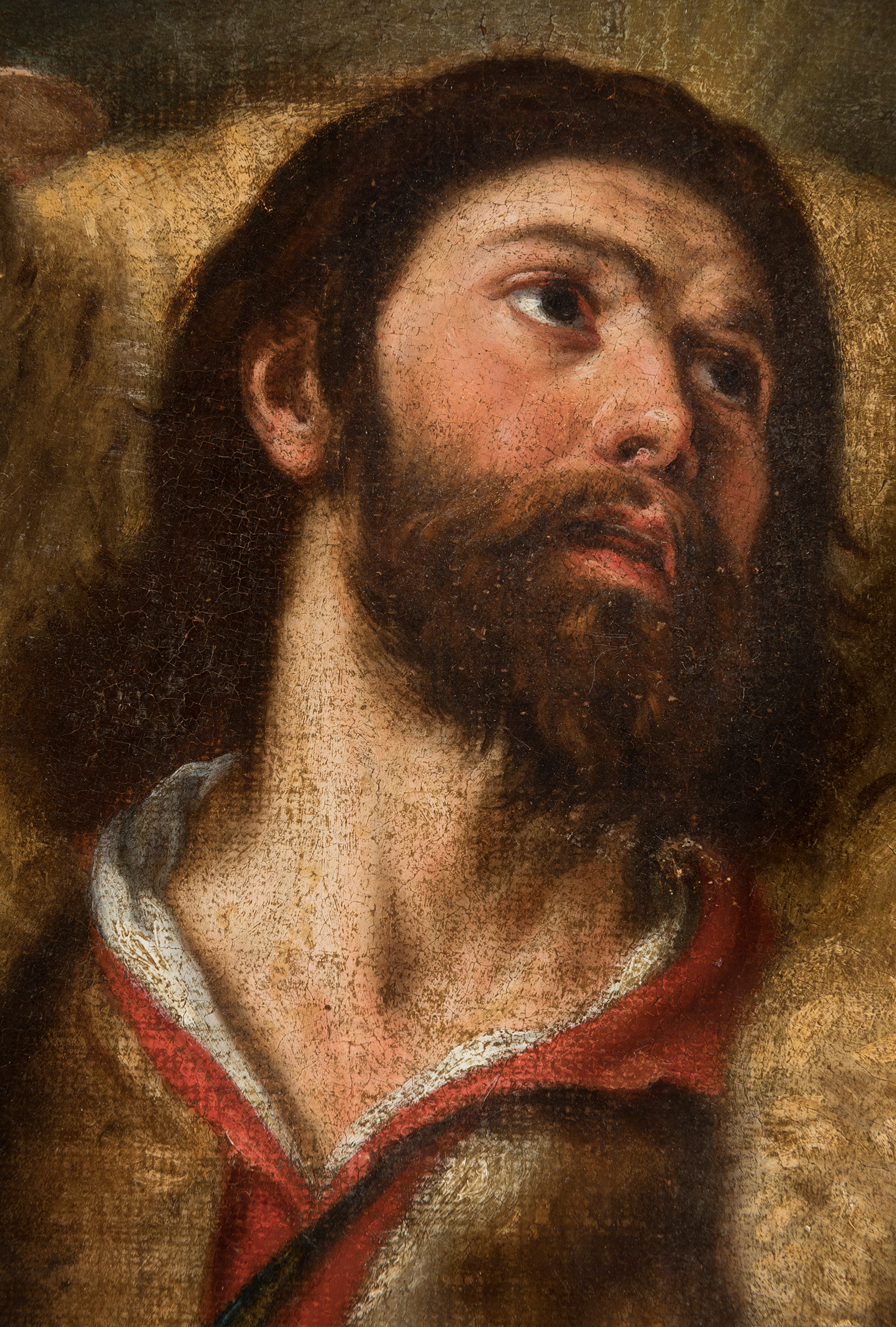4
Spanish master; first half of the 17th century."The Good Shepherd.Oil on canvas.Size: 97 x 75,5 cm.
"The Good Shepherd.
Oil on canvas.
Size: 97 x 75,5 cm.
This composition testifies the hand of a skilful painter, it presents a theme that became popular in the religious painting of the baroque period. Following the iconography that identifies Jesus with the Good Shepherd, and the sheep with humanity, the flock is here crowded around the representation of Christ in full body and in adulthood, a characteristic feature since the idea of a Child Jesus as the Good Shepherd was more widely accepted. In the foreground the figure of Christ, dressed in a red tunic in allusion to the Passion, holds a lamb on his shoulders, an heir to classical antiquity, specifically to the representation of Hermes Christophorus, and the pose with the leg forward and the knee slightly bent also refers to the classical aesthetic tradition. The landscape develops in depth, and although the foreground is taken up by the presence of the flock swirling around the figure of Jesus, located in the strict centre. On the left, located in a clearing, we can see the sketch of two figures, perhaps alluding to Saint Michael, a frequent figure in this type of representation, but there are no recognisable attributes that might make these figures recognisable. The scene is very similar to the work belonging to the Museo del Prado collection, "The Good Shepherd", painted by the artist Cristóbal García Salmeron (Cuenca, 1603 - Madrid, 1673).
The theme of the Good Shepherd is a very ancient one in Christian art, and has its roots in ancient Western art, specifically in the Muscophores of Ancient Greece. Christians would follow these iconographic models for their first representations, as we see in examples such as the catacombs of Saint Callixtus. In terms of meaning, the Good Shepherd is a biblical allegory, originally referring to Yahweh and later to Jesus Christ. The good shepherd is interpreted as God, who saves the lost sheep (the sinner). The theme appears in the Old Testament, and in the Gospels the same allegory is applied to Jesus as the Son of God. This iconography shows the Parable of the Good Shepherd in the Gospels (John 10:1-6; Luke 15:3-7), which speaks of the shepherd who goes in search of the lost sheep, and which was foreshadowed in Psalm 23 and in the Book of Ezekiel (34:12), linking God with the figure of the shepherd who cares for the sheep, his flock. In art, the theme is the most widely represented in early Christian iconography, and testimonies can be found from the 2nd century onwards. From the 4th century onwards, its representation declined until it disappeared completely in the Middle Ages, but it finally recovered between the 15th and 16th centuries. In the 17th century, it shared the limelight with the Divina Pastora, a theme that became popular in the Baroque period.
"The Good Shepherd.
Oil on canvas.
Size: 97 x 75,5 cm.
This composition testifies the hand of a skilful painter, it presents a theme that became popular in the religious painting of the baroque period. Following the iconography that identifies Jesus with the Good Shepherd, and the sheep with humanity, the flock is here crowded around the representation of Christ in full body and in adulthood, a characteristic feature since the idea of a Child Jesus as the Good Shepherd was more widely accepted. In the foreground the figure of Christ, dressed in a red tunic in allusion to the Passion, holds a lamb on his shoulders, an heir to classical antiquity, specifically to the representation of Hermes Christophorus, and the pose with the leg forward and the knee slightly bent also refers to the classical aesthetic tradition. The landscape develops in depth, and although the foreground is taken up by the presence of the flock swirling around the figure of Jesus, located in the strict centre. On the left, located in a clearing, we can see the sketch of two figures, perhaps alluding to Saint Michael, a frequent figure in this type of representation, but there are no recognisable attributes that might make these figures recognisable. The scene is very similar to the work belonging to the Museo del Prado collection, "The Good Shepherd", painted by the artist Cristóbal García Salmeron (Cuenca, 1603 - Madrid, 1673).
The theme of the Good Shepherd is a very ancient one in Christian art, and has its roots in ancient Western art, specifically in the Muscophores of Ancient Greece. Christians would follow these iconographic models for their first representations, as we see in examples such as the catacombs of Saint Callixtus. In terms of meaning, the Good Shepherd is a biblical allegory, originally referring to Yahweh and later to Jesus Christ. The good shepherd is interpreted as God, who saves the lost sheep (the sinner). The theme appears in the Old Testament, and in the Gospels the same allegory is applied to Jesus as the Son of God. This iconography shows the Parable of the Good Shepherd in the Gospels (John 10:1-6; Luke 15:3-7), which speaks of the shepherd who goes in search of the lost sheep, and which was foreshadowed in Psalm 23 and in the Book of Ezekiel (34:12), linking God with the figure of the shepherd who cares for the sheep, his flock. In art, the theme is the most widely represented in early Christian iconography, and testimonies can be found from the 2nd century onwards. From the 4th century onwards, its representation declined until it disappeared completely in the Middle Ages, but it finally recovered between the 15th and 16th centuries. In the 17th century, it shared the limelight with the Divina Pastora, a theme that became popular in the Baroque period.
9th November - Old Masters
Sale Date(s)
Venue Address
General delivery information available from the auctioneer
Setdart offers Worldwide shipping
PICK UP IN ROOM: You can come and pick up your lots in our offices (Barcelona, Madrid or Valencia). At the moment of the withdrawal, you will be able to accept the current conditions of the lot by means of a document that you will sign.
YOU CAN SEND ANOTHER PERSON TO PICK UP: This person must present a signed authorization that you can find in our web page by accessing from BUY AT SETDART- LOGISTICS-DOWNLOAD AUTHORIZATION DOCUMENT. You can also send an e-mail with the requested data in AUTHORIZATION DOCUMENT to admin@setdart.com
Important Information
25% buyer´s premium
OR
21% buyer´s premium at www.setdart.com
Terms & Conditions
The maximum period to pay the lots is 7 working days. You can pay either via bank transfer or with credit card through our platform www.setdart.com (we only accept VISA or Mastercard).
BUYER´S PREMIUM: 22% Hammer price + 21% VAT from the buyer´s premium
If your piece has more than 100 years, our Ministry of Culture requires an export certificate in order for the piece to leave the country. Note that if the piece goes inside the EU, there is no cost for the export certificate. If the piece goes outside the EU, there is a cost for the export certificate. You can find more information in our Ministry of Culture website: https://www.culturaydeporte.gob.es/en/cultura/patrimonio/exportacionimportacion/exportacion/tasas.html
INQUIRIES: admin@setdart.com
Setdart guides you through the entire process, from the time of award to the day you receive your lot. Our logistics team will be happy to manage your transport, and will advise you on the best shipping method with professionals from the sector used to handling works of art and jewelry.
WE OFFER WORLDWIDE DOOR TO DOOR SHIPPING
PICK UP IN ROOM: You can come and pick up your lots in our offices. At the moment of the withdrawal, you will be able to accept the current conditions of the lot by means of a document that you will sign.
YOU CAN SEND ANOTHER PERSON TO PICK UP: This person must present a signed authorization that you can find in our web page by accessing from BUY AT SETDART-LOGISTICS-DOWNLOAD AUTHORIZATION DOCUMENT. You can also send an e-mail with the requested data in AUTHORIZATION DOCUMENT to admin@setdart.com
SETDART IS NOT RESPONSIBLE FOR THE STATE OF THE PARTS ONCE THEY LEAVE OUR FACILITIES. MRW SHIPMENTS: Once the payment is made, your lot will be packed for shipment, the logistics department will send you an e-mail notifying you of the day it leaves our warehouse, changes of address cannot be made after receiving this e-mail.
INSURANCE INCIDENTS: Coverage for the value of the auction up to 3000 ? per shipment, if the value of the auction is higher, Setdart will send you a quote including the additional insurance. The insurance company WILL NOT BE RESPONSIBLE FOR THE SHIPMENT THAT EXCEEDS THAT AMOUNT AND IS NOT FULLY INSURED. MRW INCIDENTS: Maximum notification 48 hours after receipt, after which the insurance company WILL NOT BE RESPONSIBLE AND NO CLAIMS WILL BE ACCEPTED.
E-MAIL LOGISTICS: logistica@setdart.com
PICK UP YOUR MESSAGES: You can send your own messaging, prior notice via e-mail that your shipment is ready, please note 3 or 4 days in advance. This type of shipment is packaged so Setdart will provide you with a quote.
EXPENSES FOR STORAGE: We inform you that if the purchased lot is not picked up within a month, you will be charged 30€ per week per lot. Setdart Online S.L., owner of the web site "setdart.com", "setdart.net" and "setdart.org", acts as a company of Spanish nationality inscribed in the Volume 36955, sheet 182, page B-293056 of the Mercantile Registry, with registered office at Calle Aragó















